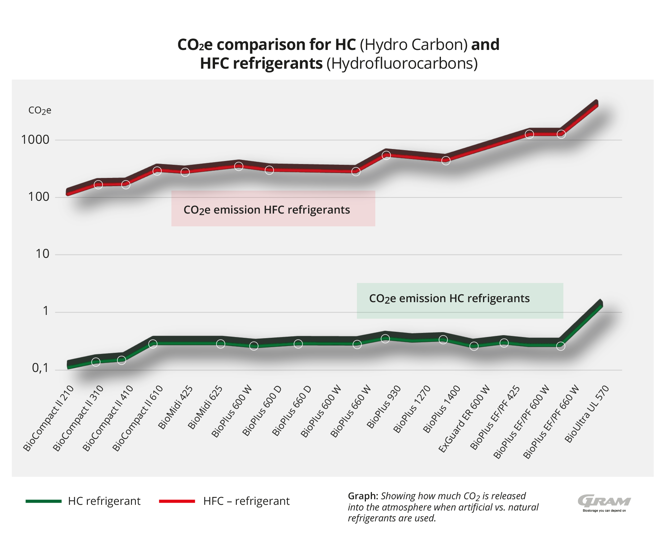HC's – Hydrocarbons
Hydrocarbon refrigerants consist of naturally occurring elements – hydrogen and carbon and have little impact on the earth’s climate, should it escape into the atmosphere. They are also called natural refrigerants. HC refrigerants has a of Ozone depletion potential (ODP) of 0.00 and Global warming potential (GWP) of 3. Typical hydrocarbon refrigerants for Gram BioLine refrigerators and freezers are Propane (R-290) or Isobutane (R-600a). Hydrocarbons are non-toxic, but comes with high risk of flammability, which means authorized personnel during installation and service is a necessity.
HFC's – Hydrofluorocarbons
Hydrofluorocarbons are man-made gases, produced for use in refrigeration, air-conditioning etc. HFC refrigerants are being phased out due to their negative impact on global warming. HFC’s have a Ozone depletion potential (ODP) of 0.00, but a Global warming potential (GWP) of 600-2000 pending on the refrigerant. HFC’s are still a widely used refrigerant in many sectors, but especially in EU, the F-gas Regulation means a great focus on phasing out the refrigerant.
Consequence on Global Warming
The difference between using a HC (natural) refrigerant vs. a HFC refrigerant is massive. In the graph, the test products are the same, however the difference in CO2e emission is times 1000 when using HFC refrigerants compared to natural refrigerants (HC). It means that one cylinder with 1 kg of R134A (HFC refrigerant) will burden the atmosphere with 1100 kg if released into the air.

Natural refrigerants are more energy efficient
The benefits of natural refrigerants are, besides being more environmentally friendly, that they are also more energy efficient. The below graph shows energy consumption when comparing HC (r600a) with HFC refrigerants (R134a). Due to HC refrigerants’ thermodynamic properties as well as high latent heat of evaporation, we see increased efficiency compared to HFC refrigerants.

If you want to read more about history of refrigerants, we recommend the article below:

